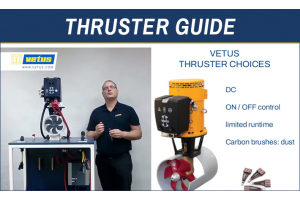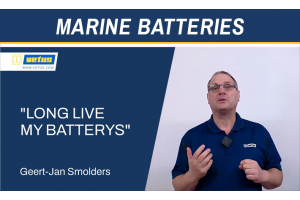
In electrical systems involving DC motors—specifically in applications like DC bowthrusters — low voltage can lead to operational inefficiencies and even permanent damage. DC thrusters, like other motors, are particularly sensitive to voltage drops, inadequate wiring, and insufficient power supply.
Newer Vetus thrusters are equipped with built-in thermal protection (a thermo switch) that automatically cuts off operation if the motor gets too warm. This feature helps prevent overheating and extends the life of the motor, but it's still crucial to avoid conditions that could trigger the thermal switch, such as low voltage caused by faulty wiring or improper battery selection.
This article explores the causes of low voltage, the importance of proper battery requirements, and how thermal protection in modern thrusters helps protect the system.
1. The Impact of Low Voltage on DC Thrusters, Motors, and Solenoids
Voltage Drop from Insufficient Wire Dimensions
When the cross-sectional area of the wire is too small for the amount of current being carried, it increases the resistance in the system, leading to a voltage drop. This means the voltage supplied to the thruster motor or solenoid may be lower than required, causing issues such as:
In solenoids, low voltage can prevent the solenoid from fully actuating, causing incomplete or weak contact closure. This can result in arcing between contacts. In DC circuits, where current flow is continuous, these arcs can be sustained, leading to overheating and melting of the contacts.
In DC thruster motors, low voltage results in inadequate power to operate the motor effectively. To compensate, the motor tries to draw more current, which can lead to overheating of the motor windings. Over time, this can cause permanent damage, including insulation breakdown and motor failure.
Thermal Protection in Vetus Thrusters
To prevent damage from overheating, newer Vetus DC thrusters are equipped with a thermo switch that automatically terminates operation if the motor reaches a certain temperature. This feature protects the motor from excessive heat caused by high current draw, typically resulting from low voltage, insufficient wiring, or extended operation under load.
While the thermo switch provides a critical layer of protection, it’s still important to address the root causes of low voltage to avoid frequent shutdowns and prolong the life of the thruster. The thermo switch is designed to protect against damage, but relying on it too often can indicate underlying issues with power delivery that need to be addressed.
Impact of Bad Connections
Loose or corroded connections can also result in voltage drops. High resistance at these points reduces the voltage supplied to the motor or solenoid:
In solenoids, bad connections exacerbate arcing by causing inconsistent current flow. This leads to more frequent arcs and localized overheating, potentially damaging the solenoid.
In DC thrusters and motors, bad connections cause erratic or insufficient power delivery, forcing the motor to operate inefficiently, increasing the likelihood of overheating and triggering the thermal protection system.
Effect of Low Battery Charge or Faulty Batteries
If the system is powered by batteries that are undercharged, faulty, or not fully charged, it can result in low voltage throughout the system, affecting both the solenoid and the thruster motor:
In solenoids, insufficient voltage causes weak or inconsistent operation, increasing the likelihood of arcing and damage to the contacts.
In DC thrusters, low battery voltage forces the motor to draw excessive current to maintain performance, leading to overheating. In this case, the thermo switch in Vetus thrusters would cut off operation, but repeated occurrences could point to battery or wiring issues that need to be addressed.
2. Cold Cranking Amps (CCA) and Battery Selection for DC Thrusters and Motors
One of the most important factors in selecting the correct battery for a DC thruster motor is the battery’s Cold Cranking Amps (CCA) rating. CCA measures how much current the battery can deliver at -18°C for 30 seconds while maintaining a minimum voltage of 7.2 volts for a 12-volt battery.
Why CCA Matters for DC Thrusters
DC thrusters, especially those used in marine applications, often experience high inrush currents at startup, which can be several times higher than the motor’s regular operating current. Selecting a battery with an appropriate CCA rating ensures that the motor gets enough current to start reliably and run smoothly, particularly in high-demand or cold environments.
High Starting Current:
DC thrusters require significant current at startup. If the battery’s CCA rating is too low, the thruster may fail to start or operate inefficiently. A higher CCA rating ensures that the battery can handle the inrush current without voltage drops that could cause the motor to overheat or trip the thermal protection.
Cold Temperature Operation:
In colder climates or environments, a battery's efficiency decreases, reducing its ability to supply the required current. The CCA rating is critical for ensuring reliable performance in cold conditions, so the thruster motor can start and run effectively without triggering the thermal protection due to excessive current draw.
Preventing Overloading:
Choosing a battery with too low a CCA rating may result in overloading, where the battery struggles to supply enough current to the thruster. This can cause the motor to overheat and activate the built-in thermo switch, cutting off the motor's operation to prevent damage. To avoid this, always ensure the battery’s CCA rating is adequate for the motor's starting current demands.
3. Ensuring Reliable Operation and Avoiding Low Voltage Issues
To prevent low voltage issues and ensure smooth, reliable operation of your DC thruster or solenoid, consider the following best practices:
Use Proper Wire Dimensions:
Ensure that the wires have a sufficient cross-sectional area (measured in square millimeters, mm²) for the current being carried to avoid excessive resistance and voltage drops.
Maintain Good Connections:
Regularly check all terminals and connectors to ensure they are clean, tight, and free of corrosion. Poor connections increase resistance and contribute to voltage drops.
Select the Right Battery:
Choose a battery with a sufficient CCA rating to meet the thruster motor’s inrush current needs, especially in cold environments or during high-load operation.
Monitor Battery Health:
Periodically check the health and charge status of the battery to ensure it consistently supplies the required voltage and current.
Use the Thermo Switch as a Last Line of Defense:
While the thermo switch in Vetus thrusters protects the motor from overheating, frequent activation could indicate underlying power supply issues, such as low voltage or high current draw due to wiring problems or inadequate battery capacity. Address these issues to minimize reliance on the thermo switch and ensure long-term reliability.
Conclusion
Low voltage, whether caused by insufficient wire dimensions, bad connections, or undercharged batteries, can have serious consequences for DC thrusters, motors, and solenoids, leading to arcing, overheating, and damage. In newer Vetus DC thrusters, a thermo switch helps protect the motor from damage due to overheating, but frequent activation indicates underlying voltage or power issues that must be addressed. Selecting the correct battery with an appropriate Cold Cranking Amps (CCA) rating ensures reliable performance, particularly during high-current startup conditions or in cold environments. By using proper wiring, ensuring solid connections, and choosing a suitable battery, you can avoid low voltage problems, maximize the effectiveness of the thruster, and extend the life of your electrical components.


















